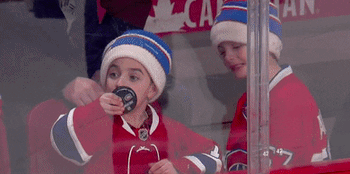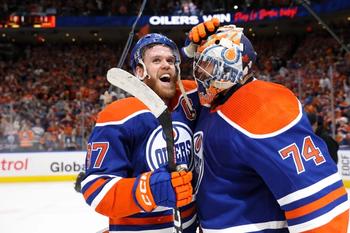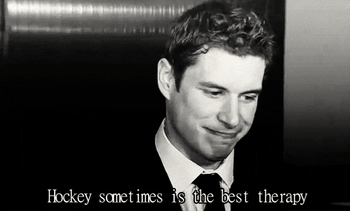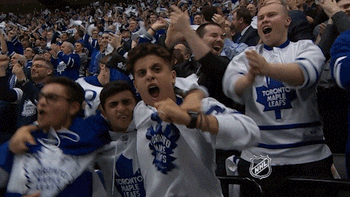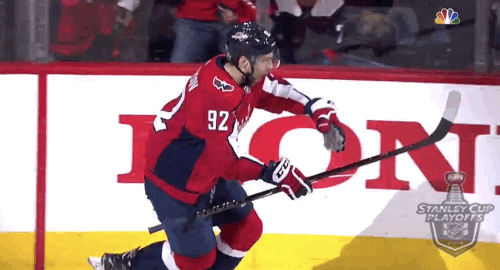
Period
A hockey game consists of three 20 minute periods.
Overtime
If there’s a tie at the end of the game, it goes into overtime, also known as OT. During the regular season, OT is five minutes long of three-on-three hockey (as opposed to the regular five-on-five) which means there’s much more room for the players to speed around and make long passes. If it’s still tied at the end of OT, the game goes into a three-player shootout to decide a winner.
IMPORTANT: There are no shootouts in the playoffs, the game just continues with 20 minute five-on-five overtime periods until a team can score a goal.
Shootout
A shootout happens at the end of a tie game in the regular season. Each team chooses three shooters to go one-on-one with the other team’s goalie. If it’s still tied after each team takes their three shots, teams select one player at a time until one team comes out on top.
Hat trick
Three goals in one game by the same player. When a player gets three goals, it’s tradition for the fans to throw their hats on the ice in celebration. Pro tip: if you want to get in on the tradition, leave your expensive hat at home.
Natural hat trick
One player scoring three successive goals — as in no one from your team or the other team scores in between. Talk about overachiever.
Gordie Howe hat trick
Named after the infamous Gordie Howe. It’s when you get a goal, an assist and a fight all in one game. It doesn’t get much more “hockey” than that.
Slap shot
When you see the shooter wind up and bring their stick up above their waist and just LET ‘ER RIP. NHL players can sometimes get their pucks moving as fast as 160km/hour. Imagine trying to stop that!
Wrist shot (wrister)
The kind of shot where you curl it back and let it fly with a flick of the wrist to put the puck exactly where you want it to go. This shot is not as hard as a slapper, but generally, a lot more accurate than the slap shot and is all about agility and quick release.
One-timer
When someone shoots the puck directly off a pass without stopping to control the puck. Alexander Ovechkin (Washington Capitals) is absolutely known for this shot.
Maurice ‘Rocket’ Richard Trophy
A name to know! He played for the Montreal Canadiens and was the first player ever to score 50 goals in one season. He was also the first to reach 500 career goals. There’s a trophy in his name that’s awarded annually to the leading goal scorer in the NHL.
Calder Trophy
Awarded to the Rookie of the Year who really impressed in their first NHL season.
Hart Memorial Trophy
This award is given to the MVP (most valuable player) of the NHL’s regular season. While the Stanley Cup is the highest team honor, this is the highest individual honor in the league.
Vezina Trophy
An award given to the best goaltender of the regular season.
Conn Smythe Trophy
This trophy is a beauty. It’s awarded to the player that is the MVP during the Stanley Cup playoffs (rather than the regular season).
Stanley Cup
AKA Lord Stanley! *Baby this is what you came for* The name of the game is to win the Stanley Cup at the end of the season and playoffs. Once you win it, your name is engraved on the Cup forever (kind of).
Conference Finals
Think semifinals. It’s called the Conference Finals because the best two teams in the East play each other while the best two teams in the West play each other. The winners of those series will play one another for the Stanley Cup.
Penalty
When a player does something that’s against the rules (e.g., hooking, tripping, diving, fighting, slashing, etc.). When this happens, the player is sent off for two minutes, five minutes, 10 minutes or a whole game (if the infraction was real bad). That player’s team must play shorthanded until the penalty is fully served. Not good.

Shorthanded
Shorthanded means your team is playing a player down because a teammate managed to find their way into the penalty box. If your team ends up scoring even when you’re down a player, it’s called a shorthanded goal. It’s something special that should be celebrated!
Penalty Kill
Your team gets a penalty and are therefore down a skater. So, you try to kill off (aka not let the other team score) that penalty. When you're killing a penalty, you're allowed to ice the puck (see below).
Icing
This is when a team fires the puck down the ice from their side of the red (center) line and it goes all the way past the other team’s blue goal line without touching anyone along the way. The whistle is blown and play is stopped, and the puck comes back to the defensive zone of the team that iced the puck.
Teams will ice the puck sometimes by accident, during a penalty kill (in which case they’re not penalized), or if they’re tired and just want to get the puck out of their zone. However, the team that ices the puck can’t make a change (make subs) so it’s not the best strategy.
Face-off
To start any play you first need to have a face-off. The five players on each team assemble in their designated positions. The ref drops the puck into the middle of the two center forwards and they battle each other to gain possession of the puck first.
Powerplay
The other team has a player in the penalty box so that you have one more player than your opponent (five vs. four) for the duration of the penalty. Once/if you score, the penalty is over and the opponent can come out of the penalty box (unless it was a major penalty). Just like the penalty kill above, there are detailed lineups and plays to capitalize.
SOGs
Shots on goal.
GAA
Goals against average. This is calculated by goals allowed times game length (usually 60 minutes) then divided by minutes played. This includes overtime goals but not empty net or shootout goals.
TOI
Time on ice.
Breakaway
You have the puck, look up and there is no one between you and the goalie. OH BABY!
Offside
This is a big part of hockey with the blue line representing the offside line. On offense, you can’t enter the zone until the puck does to prevents cherry-picking.
It also means that once your team is in the zone, it’s important to try to keep the puck in for as long as possible, because once it goes back across the blue line and out of the zone, all players need to leave the zone too before the puck can be brought back in. On the flip side, the defensive team will be just trying to ‘clear the zone’ and get the puck out to force all the offensive players out.
Assist
Awarded to the player who passes the puck or the last person to touch the puck before the player who scores. Normally, two assists are given for each goal, representing the last two players to touch the puck before the goal scorer.
SV
Save percentage for a goalie. AKA amount of goals stopped divided by the total amount of shots on net.
Goaltender Interference
You know that blue half circle at the front of the net. That’s called a crease. A player is not allowed to make contact with the goalie in the crease or the goal can be disallowed. These are pretty hard and controversial calls for a ref to make.
Lockout
Essentially a strike for hockey players, but in this case the team owners “lockout” the players until they can reach an agreement on their union contract. There have been four lockouts in NHL history. The NHLPA (Players Association) and the NHL big wigs (owners) negotiate terms to play. Generally, one side thinks the other side is getting paid too much.
Don Cherry
Affectionately known as ‘Grapes’, Don Cherry hosted Coach’s Corner during the first intermission of Hockey Night in Canada (HNIC) along with Ron McLean every Saturday for almost four decades. However, in November of 2019, Don was fired by Sportsnet for making inflammatory and racist comments during a Coach’s Corner broadcast just before Remembrance Day.
The firing created a huge divide within the hockey community as players and fans alike who grew up watching Don on TV were outraged that he could ever be fired. But the NHL has been pushing the #HockeyIsForEveryone moniker for years, and Don’s comments couldn’t go without consequences. Frankly, Don had been making misogynistic and questionable comments for years, and we were happy to see HNIC get a fresh start.
Stood on his head
Used to describe an outstanding performance by a goalie, typically in a short period of time. It looks something like this.
Where does this phrase come from? When a goalie makes a save they often fall to their side, stacking up their pads and appearing to stand on their head.
Enjoying this article? Want more?

Sign up for The GIST and receive the latest sports news straight to your inbox three times a week.
